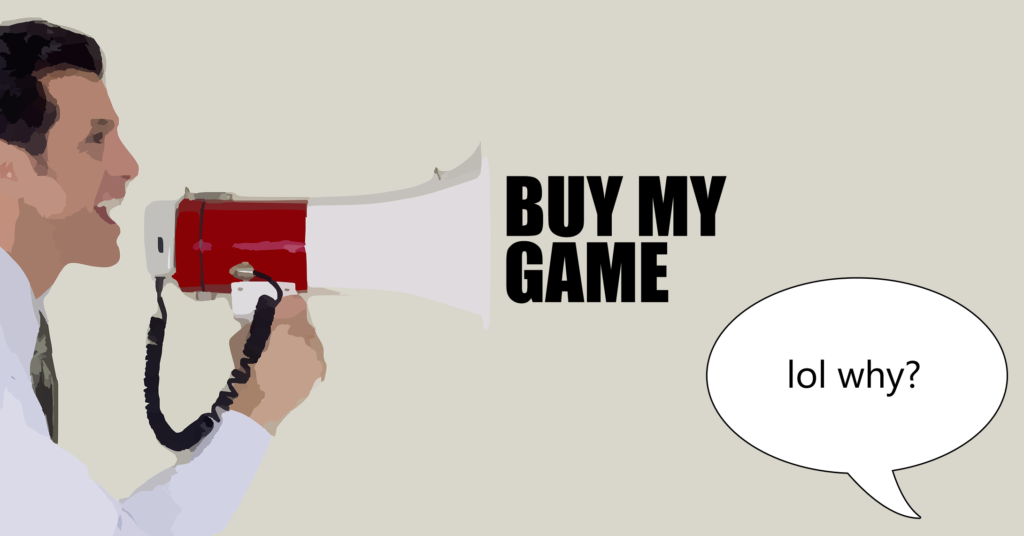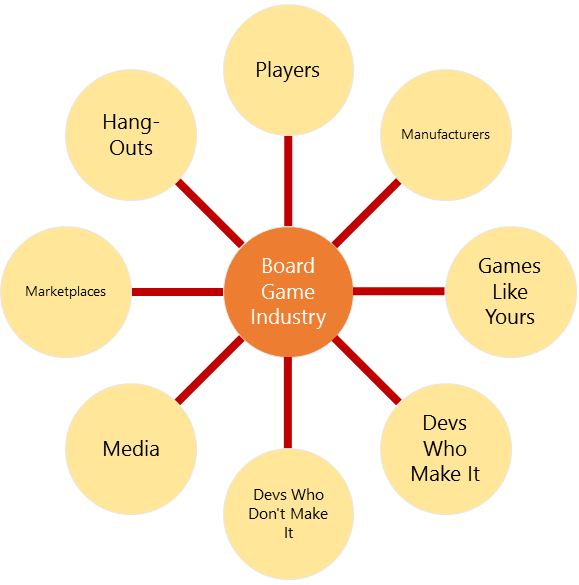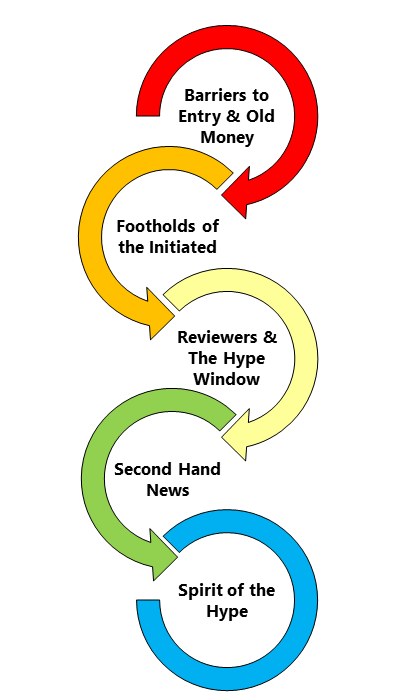This is not a post about what you need to do, think, or spend to make a game, nor is it a post about board games themselves. This is a post about the players in a much bigger game: the board game industry itself. It’s time to talk about your potential customers, the eight powerful groups in the board game industry, and The Hype Machine.

Looking for more resources to help you on your board game design journey?
Here you go: no email required!
Like this writing style?
Check out my latest blog on marketing here.
Your Potential Customers
It feels unnatural to refer to players as customers when you first do it. This is something you will need to make peace with if you plan to self-publish your game, since they are one and the same. Marketing and promotion is an ongoing process and you can’t shortcut it if you want to sell your print run or crowdfund some of the costs.
To respond to that grossed-out schmoozy feeling you might get from referring to players as customers, ask yourself this question: “why is it bad to be sold to?” The answer is going to be some variation of “I don’t want or need the thing and/or I cannot afford it.” There is nothing intrinsically wrong with selling things you work hard on. The weird feeling that comes with selling stems from either selling bad stuff or from selling to the wrong people.
The most ethical way to sell, and indeed, effective way to sell is to have a crystal clear picture of your customers. What do they like? What do they dislike? How old are they? How much money do they have? Where do they hang out? How do they talk? How do they like to be approached? Why do they like the things they like and dislike the things they dislike?
In general, hobby board gamers tend to be males around 30 who have discretionary income. That narrows it down some, but that’s still too broad to be useful. You need to know the specific sort of people who would like your game and you need to know how they think.
“How do I do that?”
- Get a Twitter (or some social media site you prefer).
- Create a private list.
- Find games like yours.
- Find people who follow games like yours. Look for people within that group who might like your game. Add them to the list.
- Read what they say for a while. Be a fly on the wall.
Good selling starts with listening. Customer relationships work like friendships and romantic relationships: by attending to the needs of others within the boundaries of what you can reasonably do. Get to know people so well that you can rattle off a description of who they are and what they like.
Powerful Groups within the Board Game Industry

Where there are people interested in something, that interest will result in a complex series of social structures. In board games, for the sake of this conversation, we’ll refer to them as the “board game industry.” It’s a bit silly to treat it as a singular monolith, as the board game industry is made up of nothing but individuals. Anyhow, when these people get together, they tend to become parts of eight influential groups.
Group 1: The Players
Everything in board gaming starts with the players. Players determine which types of games are profitable and how much they are willing to pay to play. Players gather in different places, ultimately determining which websites are popular, which bloggers are read, which podcasters are listened to, which conventions are attended, and – most importantly – which games are played. If there is one group you need to pay attention to it’s the players. If you make a board game, you want to spend more of your time communicating with players than any other group.
Group 2: The Manufacturers
Ever wonder why a lot of board games come with punch-out tokens instead of metal cubes? It all comes down to manufacturing costs. Manufacturers determine which game pieces are cheap to make, and by extension, have a good deal of influence over what players play and what becomes popular and expected. On a more personal note, good manufacturing is critical to your game being well-received, but for now, I’m sticking mostly to industry-level effects. In that sense, manufacturers collectively set expectations for how nice a board game will feel in players’ hands.
Group 3: Games Like Yours
Board games work sort of like books and music as an industry. Games tend to complement each other instead of directly compete. This is partially due to the collector mentality, partially due to the “luxury hobby” status of board gaming, and partially because of the “if you like X, you’ll like Y” effect. That said, you have to pay attention to board games that resemble the ones you’re making. For starters, you don’t want to accidentally create a knock-off Catan. Perhaps more importantly, though, it becomes really important to pay attention to games like yours so that you can make comparisons that gamers can understand.
Oh, so your game – War Co. – is sort of like Netrunner and Star Realms…
Group 4: The Devs Who Make It
You’ll need to pay attention to the game developers who make it since they influence the thought patterns of players, fellow designers, and perhaps even manufacturers if they do something truly innovative that has a flattering cost/benefit case behind it. The success of Pandemic Legacy is leading people to make legacy-type games. The success of Jamey Stegmaier has led people to start blogs as a form of customer outreach. Watching what other successful people do gives you an idea of what direction the board game industry will go in.
Group 5: The Devs Who Don’t Make It
Of course, if you only look at successful game developers, you’re getting about half of the picture. Survival bias makes us think that all we have to do is copy successful people’s behaviors. Not so! You need to pay attention to game developers who cannot get their game Kickstarted. You need to pay attention to people who cannot break 1,000 Twitter followers. Pay attention to people who fulfill their game late, the people who run out of inventory, and the people who go out of business.
They subtly affect the behaviors of game developers in the industry as well.
Group 6: The Media
Board game media includes everyone from the juggernauts behind Dice Tower, Shut Up & Sit Down, and Tabletop to the podcasters who get five downloads per episode. There is no shortage of reviewers, bloggers, podcasters, YouTubers, and streamers who all have subtle affects on the way that board games are perceived. Pay attention to the trends you see. One popular one I’ve seen lately is “play-throughs” on YouTube that show people what a game is like without them having to read the rules to learn. In fact, these channels have replaced rulebooks for some players entirely.
Reviews hold a massive amount of sway in whether or not people will buy your game. Bloggers have the ability to get people to click on your links at convenient times. Podcasts, for whatever reason, have the ability to get a brand name in your head like nothing else. Live streams, an incredibly underrated tool for outreach, has the ability to get you noticed by small, tight-knit communities of 15 and 20 – enough to start a movement.
Group 7: The Marketplaces
Kickstarter and Amazon are the go-to marketplaces for board games right now. When they do something different with games, it creates ripples throughout the whole industry. Kickstarter is a whole community in its own right. Pay attention to what gets noticed on those platforms and others that may take their places in the future.
Group 8: The Hang-Outs
Finally, board games are intrinsically social. The places that people talk about and play board games have a huge effect on how board games are sold, seen, and played. Online, there are communities on Twitter, Facebook, Instagram, Reddit, Board Game Geek, and probably more places that I don’t even know the existence of yet. Offline, there are gaming stores and board game meetup groups. Get to know some of these hang-outs. Find one that works for you. I’d suggest finding one offline and one online. Pay attention to the trends in the hang-outs you use. Changes to them will change your approach to making and marketing your game.
The Hype Machine

When you get a bunch of people together, passions will run high and money will get passed around. It’ll create movements and excitement. Empires will be born and empires will crumble. A collective “spirit of the times” will rip through the community. In board games, I refer to this spirit of the time as “The Hype Machine.”
The Hype Machine determines which games people get really excited about. The Machine determines which games make $50,000 on Kickstarter and which ones make $5,000,000. The Hype Machine, just like the industry, is a metaphor for a complex mix of decentralized and disorganized factors which together influence people’s attitudes toward board gaming, board gamers, and board games.
Part 1: Barriers to Entry & Old Money
Like it or not, board games are expensive to create. They take thousands of dollars for manufacturing alone and thousands more for art. This is not accounting for the immense amount of time it takes to get started. Because it takes so much time and often tens of thousands of dollars to get off the ground, board game companies who have already successfully created board games have a big leg up. These companies meet the economic requirements of what comes next…
Part 2: Footholds of the Initiated
Because it costs so much money and takes so much time to get started, only a handful of board game companies and developers manage to survive past the “idea stage.” Board gamers are sometimes jaded to the idea of new game developers, saying things like “most Kickstarters suck” and “new game devs are a dime a dozen.” The flip-side of this negativity is that once a developer or a company successfully publishes just one game, they establish a reputation. If they publish several, that’s very impressive. Having a good reputation and enough money to keep making games are the “footholds of the initiated.” These things impress people and make players get excited about upcoming games from studios they’ve seen succeed before.
Part 3: Reviewers & the Hype Window
After crossing a certain threshold, game companies can start to make games that people actively, eagerly await. This is a massive step for a company and it takes a long time for a new developer to get there. Once games reach a certain point in popularity, new reviewers – who themselves are trying to become more popular – may feel uncomfortable expressing opinions outside of the norm. Because of that, game reviews will start to cluster around a certain consensus.
There are lot of great small reviewers who avoid falling into this trap. Many do not. I believe that when reviews cluster around the same basic point range of, say, 7-9 that players start to think “wow, this game is really good if it’s getting an 8 on all these channels.” In reality, reviewers who are just getting started don’t want to step outside of that “Hype Window.” Just as few music reviewers give the Beatles a bad score (even if they hate them), few game reviewers will give Scythe a bad score. Often times, this is simply because they play it more until they “understand the hype.”
There is a fair argument to be made that even the big-name reviewers with established brands are trapped by the expectations of their readers, but I haven’t seen too much evidence to support this yet.
Part 4: Second Hand News
It’s hard to get started because of money and time, but once a company has successful games and a reputation, they have a disproportionate impact over some not-insignificant portions of the reviewer base. Reviewers tend to be thought leaders whose opinions are repeated in blogs and podcasts, as well as by other gamers. People look at and continue to repeat the findings of these reviews until games are consistently perceived in a certain way by a large population of gamers.
This is hype right here. Not every person plays into it. This is not a neat, linear process that follows immutable laws of nature.
Part 5: Spirit of the Hype
Once Second Hand News reaches a certain critical mass, it becomes common knowledge. Twilight Struggle is the best game because people went around saying it was the best game for a long time. Monopoly is terrible because people say it’s terrible. Once these narratives are in place, they’re very hard to change.
So Now What?
This is a big picture painted with theoretical notions based on opinions I’ve formed over years of time. How can a new game dev learn from this, though? What’s the point?
Understand that you’re part of a bigger picture. The board game industry is a large, decentralized community made up of tons of individuals acting in complicated ways. You’re not going to understand it all in a day, week, year, or 10 years.
Take your time. Not only does it take a long time to make games, but it takes a long time for people to care about you making games.
Get to know individuals one-on-one. The most important thing you can do to get people to care about you is to care about them. Talk to lots of gamers.
Listen.
Don’t believe the hype. Trends come and go. Keep your head steady and form your own opinions. Listen to others, but don’t let go of who you are and what you like.





7 thoughts on “The Board Game Industry: Powers That Be & The Hype Machine”
What if we have a the prototype completed, we’ve played the game at least 50 times, we’ve created the video & we’re pretty confident it’s a great game? What do we do next?
Thanks so much for this wonderful series of blog posts. This one in particular is exactly what I need to hear right now! I’m going to be rereading this several times as I promote my first board game and immerse myself in the tabletop gaming culture.